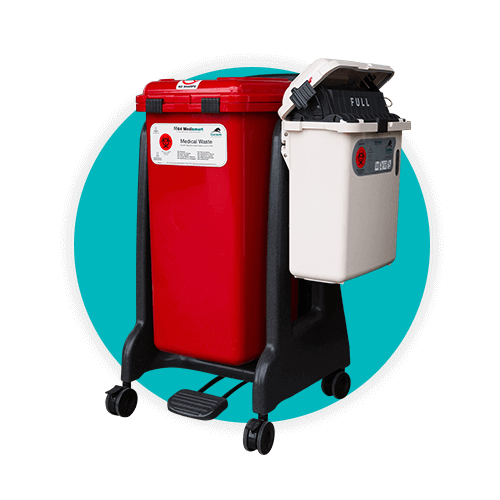How to Manage Biohazard Waste in San Antonio

If you’re a healthcare worker, chances are you’ve encountered standard procedures mandating how to manage biohazard waste in San Antonio, Texas. As waste stream regulations vary across state lines, the Texas Department of Health mandates specific compliance with biohazard waste in your medical facility. Does everyone on your staff know how to segregate waste streams?
What do you think would happen if you gave your medical staff a pop quiz and asked them: What is biohazard waste and how is it managed? Raised eyebrows? Crickets?
Located in Bexar County, we know that San Antonio is a great place to work and live. It’s the home of the Alamo, the Tower of the Americas, the Enchanted Rock State Natural area and the Natural Bridge Caverns. What’s not to love about San Antonio?
We can think of something.
Biohazard waste.
Compliance with Texas biohazard waste regulations a must
Why is biohazard waste management in San Antonio so important? Every city in Texas must adhere to state and federal regulations regarding medical waste management and proper disposal. While we hate to start off with worst-case scenarios when it comes to noncompliance, penalties are a reality, not to mention they keep us safe! The Texas Commission on Environmental Quality (TCEQ) evaluates harmful and severe violations when determining penalties.
It’s not just the TCEQ that Texas healthcare facilities have to worry about, but also:
- Texas water codes
- Texas health and safety codes
- Texas transportation codes
Each of the statutes of Texas administrative authorities also have the authority to assess penalties and fines. We haven’t even mentioned federal penalties for noncompliance. As an example, statutes in Texas authorize administrative penalties of up to $25,000 per violation per day for medical waste noncompliance.
Can your hospital, physician’s group, or sole practitioner afford that? Not to mention damage to reputation.
Repeat offender penalties are “enhanced” by 25% and administrative penalties can be modified depending on the classification of the facility or business under enforcement action.
Okay, now that the punishment phase is out of the way, it’s time to ask: are you up to date on biohazard waste management protocols for your facility?
Categorizing medical waste
In Texas, medical waste is customarily identified in four basic categories:
- General waste is generally deemed nonhazardous and doesn’t pose any biological, chemical, physical or radioactive danger to public health.
- Infectious waste has the potential to cause infection in humans and includes things such as human or animal blood and tissue, blood-soaked bandages, and pathological waste.
- Hazardous waste is a type of potentially contaminated waste that may be highly infectious to humans. Such contamination might occur through laceration, punctures, or needlestick injury or other sharps injuries and contamination from scalpels, broken glass, culture dishes, and so forth. Handling such waste without personal protective equipment (PPE) is risky. Proper disposal of contaminated gloves, gowns, and bedding is important.
- Radioactive waste is anything (equipment, tools, containers, clothing, surgical devices, and so forth), contaminated by radioactive materials, medications, or isotopes.
In San Antonio, Texas medical waste disposal follows regulations of the TCEQ, as in other parts of the state. The bulk of medical waste (including some biohazard waste) comes from the over 600 hospitals located throughout Texas, but also private doctor practices, dental facilities, research laboratories and veterinary facilities.
How well does your staff segregate types of medical waste? Is your staff familiar with not only Texas regulations regarding biohazard waste management, but federal regulations for the same? Based on federal guidelines, biohazard waste is a component of regulated medical waste and is under the purview of the Environmental Protection Agency, which has the authority - per the regulations of the Resource Conservation and Recovery Act (RCRA) - to oversee compliance in medical waste management issues, along with a number of other agencies such as the:
- Department of Transportation
- Drug Enforcement Agency
- Occupational Safety and Health Administration (OSHA)
Terminology is often confusing. For example, regulated medical waste is also known as biohazardous waste as well as infectious medical waste. Basically, these all describe any type of waste that may be contaminated with body fluids, blood, or other “potentially infectious materials.”
How many types of regulated medical waste are there? Based on the EPA guidelines, a total of seven:
- Contaminated sharps
- Uncontaminated sharps
- Human blood and blood products
- Microbiological waste
- Contaminated animal waste
- Isolation waste
As always, it’s important to read the fine print. The EPA also regulates surgical or autopsy wastes that come into contact with any type of personal protective equipment, sponges, and so forth. It also regulates dialysis waste that has come into contact with blood, as well as discarded medical equipment or parts of equipment that have come into contact with an infectious agent.
Don’t take chances. Daniels Health helps you maintain compliance.
Every category of waste has specific handling, storage, and disposal requirements. Many are state specific. Even if a facility follows all the laws and regulations of the state (in this case, Texas), it is also understood that federal regulations must also be followed.
Daniels Health knows that dozens, if not hundreds, of pages of regulations regarding the handling of biohazard waste and overall medical waste management can be overwhelming. While some hospitals and outpatient facilities are outfitted with infectious waste incinerators, it’s important to check with the state of Texas regulations for specific handling, treatment and disposal of medical waste.
For more information about Daniels Health resources and cost-saving biohazard waste management solutions, call us today.
